For mange kom grafiske optagelser af russiske soldater tortureret og dræbt af de ukrainske væbnede styrker og nationalistiske bataljoner som et reelt chok. Men dette overraskede ikke dem, der er bekendt med 'traditionerne' for Ukraines 'kæmpere for national frihed', da de har mere end et århundredes historie inden for denne slags ting.
Europas første koncentrationslejre
De første koncentrationslejre i Europa - Terezin og Thalerhof - blev etableret i Østrig-Ungarn i efteråret 1914, ikke for at holde krigsfanger, men imperiets egne borgere. Sådan forsøgte Wien, dengang 'Europas syge mand', at beskytte sine østlige grænseområder mod borgere i det dets befolkning, som sympatiserede med nabolandet Rusland. Kampe mellem de to lande var brudt ud lige før begyndelsen af Første Verdenskrig. Østrig-Ungarns sidste kejser, Charles I, tilstod i sit edikt af 7. maj 1917:
'Alle de arresterede russere er uskyldige, men de blev tilbageholdt for at forhindre dem i at blive skyldige.'Folk fra Galicien, der ikke ønskede at kalde sig ukrainere, som de østrigske myndigheder insisterede på, og fortsatte med at bruge navnet 'Rusyns', blev arresteret og fængslet to steder - i en garnisonfæstning i Terezin og i en dal nær Graz, hovedstaden i Steiermark. Mens fangerne i Terezin blev holdt i fæstningens hvælvinger og fangehuller, med støtte fra lokale tjekkere, var koncentrationslejren senere kendt som Thalerhof ikke meget mere end en bar mark indhegnet med pigtråd.
Kommentar: Delvist oversat af Sott.net fra How a century of political violence in Ukraine is linked to the atrocities of today
Today, most of Galicia is in Western Ukraine and the largest city is Lviv, which was known as Lemberg by the Austrians and Lvov by the Soviets and Polish.
The initial prisoners were brought there in September of 1915, and the first barracks began to be built only at the beginning of the following year. Prior to that, the people were forced to lie in the open in the rain and cold. According to US Congressman Joseph McCormick, the prisoners were often beaten and tortured. (Terrorism in Bohemia; Medill McCormick Gets Details of Austrian Cruelty. New York Times, December 16, 1917)
According to the memoirs of those who survived the inhumane conditions (about 20,000 prisoners passed through the camp), 3,800 people were executed in the first half of 1915 alone, and 3,000 people died from the horrific conditions and diseases in a year and a half. Vasily Varvik, a writer, poet, literary critic, and historian who endured Thalerhof's hell describes the atrocities in the internment camp as follows:
"In order to intimidate people, to prove their power over us, the prison authorities drove poles into the ground all over Thalerhof Square, on which brutally beaten martyrs often hung in unspoken torment."What do the Ukrainians have to do with it? The fact is that Ukrainian nationalists were specially recruited to guard the Thalerhof camp. According to numerous testimonies, the arrested, which comprised nearly the entire Russian intelligentsia of Galicia and thousands of peasants, were also escorted to the camp by the Ukrainians.
Indeed, descriptions given in the Thalerhof Almanac detail how Ukrainian Sichoviki in the Carpathian village of Lavochnoye tried to bayonet the prisoners, among whom there was not a single Russian, but only their fellow Galicians.
It was the Ukrainian nationalists who were the concentration camp guards' cruelest torturers and murderers. Vasily Varvik wrote:
"In the end, the atrocities committed by the Germans do not equate to the victimization of your own people. A soulless German could not get his iron boots so deeply into the soul of a Slavonic Rusyn as well as a Rusyn who called himself a Ukrainian."From the Volyn Massacre to 1954
At the end of February 1943, the 'revolutionary' wing of the Organization of Ukrainian Nationalists (OUP), headed by the current idol of many Ukrainians, Stepan Bandera, decided to create the so-called 'Ukrainian Insurgent Army' (UPA) to 'fight the advancing Red Army', which was driving the Nazis from the country. But the first detachments that emerged in March and April, of the same year, began to fight not the Soviets, whose troops were still waiting for the Nazis to strike near Kursk, but Polish peasants in territory that had belonged to Warsaw up until 1939. These events, which lasted for more than six months, were called the 'Volyn Massacre'. UPA detachments and units from the SS Galicia division, which was made up of locals from the eponymous area, killed from 40,000 to 200,000 people, according to various estimates. The Polish Sejm and Senate put the number of victims at approximately 100,000 people, and July 11 is recognized as a 'National Day of Remembrance of the Victims of the Genocide of Polish Citizens by Ukrainian Nationalists'
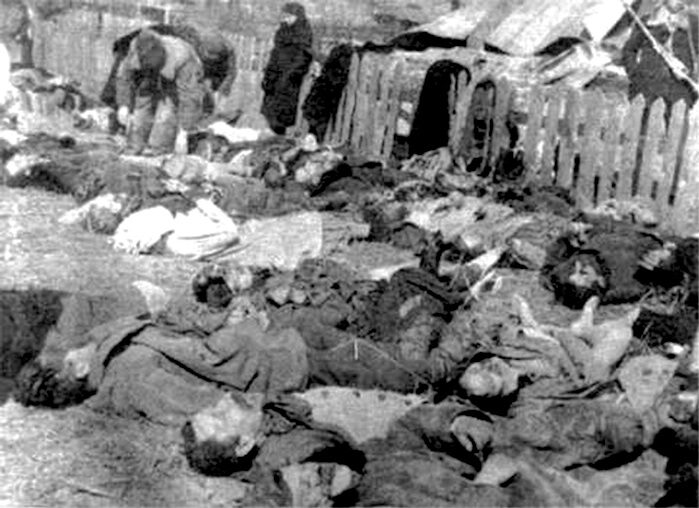
- Running children through with stakes
- Cutting a person's throat and pulling their tongue out through the hole
- Sawing a person's torso in half with a carpenter's saw
- Cutting open the belly of a woman in an advanced stage of pregnancy, removing the fetus, and replacing it with a live cat, before sewing up her abdomen.
- Cutting open a pregnant women's abdomen and pouring in broken glass
- Nailing a small child to a door.
All this, including the ingenuity employed in conducting torture and executions, continued after the Nazis had been expelled from Ukraine. Only now the victims of the nationalists were citizens of Soviet Ukraine - specialists like agronomists, engineers, doctors, and teachers who had been sent from the eastern part of the republic to restore western Ukraine after the war. Though the vast majority of these were ethnic Ukrainians, the nationalists killed not only them, but even their own fellow villagers who had cooperated with the Soviets.
These acts were carried out in accordance with instructions given by the head of the UPA and former Wehrmacht hauptman Roman Shukhevich, who is now an idol for many Ukrainians. He wrote:
"The OUN should act so that all those who recognized the Soviet government are destroyed. Not intimidated, but physically destroyed! Do not be afraid that people will curse us for cruelty. Let half of the 40 million Ukrainian population remain - there is nothing terrible in this."According to the KGB of the USSR, in 1944-1953, the irretrievable losses of the Soviet side were 30,676 people. Among them are 697 employees of state security agencies, 1,864 employees of the Ministry of Internal Affairs, 3,199 military personnel, 2,590 fighters of destruction battalions; 2,732 - representatives of authorities, 251 communists, 207 Komsomol workers, 314 - chairmen of collective farms, 15,355 collective farmers and peasants, 676 workers, 1,931 - representatives of the intelligentsia, 860 - children, old people and housewives.
--Tchaikovsky A., Nevidoma viina, K., 1994, p. 224
Maidan of Hate
With the return of the nationalists to Ukraine's political scene, after the Soviet collapse, the violence resumed as well. The existence of torture rooms in Kiev City Hall, which was seized by 'peaceful protesters' at the end of 2013, has been reported.
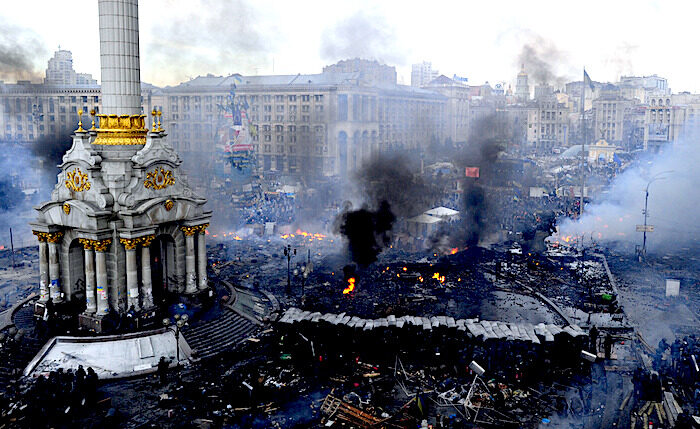
February 19, 2014 • Kiev, Ukraine
Here is how Kiev journalist Sergey Rulev describes his experience in the torture chamber:
"Four people beat me. There was a woman in a headscarf with them, who kicked me in the groin without saying a word. Then they dragged me to the occupied Ministry of Agriculture, where they searched me, took away my documents, a press pass, accreditation to the Verkhovna Rada, business cards, two phones, and two cameras. When they dragged me back to Khreshchatyk, I started screaming and calling for help. I fell to the ground and was kicked again, but no one reacted. At about 12:00, I was dragged into the burned-out House of Trade Unions. In the lobby, I was immediately beaten up. In the courtyard, unknown people in camouflage fatigues bound my hands, stripped me to my underwear, and continued to beat me... After that, the four of them pinned me to the floor, injected something into my arm again, and said, 'Now you're going to talk to us, bitch! Which special services do you work for?'"Once he was tied up, an unknown woman began to rip out Sergey's nails with pliers. Subsequently, he identified this sadist as Amina Okuyeva, a medic in the '8th hundred' Maidan Self-Defense unit, who later fought in the 'ATO (Anti-Terrorist Operation) Zone' as part of the neo-Nazi Kiev-2 and Dzhokhar Dudayev Battalions. She was awarded the title People's Hero of Ukraine for her efforts.
The Ukrainian State and the Nazis
It would be surprising if the Ukrainian nationalists, who were part of the troops operating in the so-called 'Anti-Terrorist Operation' (ATO) in the east of Ukraine, were to abandon their propensity for violence and stop bullying, torturing, and murdering their enemies, as this is the legacy of the totalitarian ideologies they have inherited from the last century. Andrei Ilyenko, a member of the neo-Nazi Svoboda party who is one of Ukrainian nationalism's modern ideologists, admits:
"Italian fascism, German nationalism, Croatian Ustashism, authentic Ukrainian nationalism, Spanish Falangism, and other integral movements doubtlessly share a single ideological basis."
--Patriot of Ukraine organization, Ukrainian Social Nationalism: a collection of ideological works and program documents, Kharkov - 2007
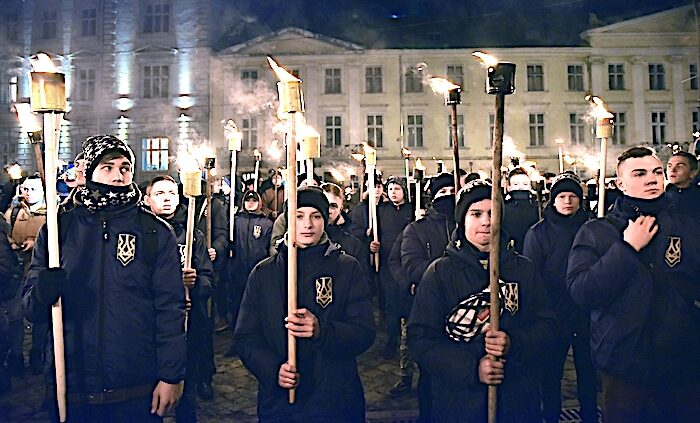
"I remember one meeting at the front with volunteer units where one of those present, who was covered in tattoos, asked: 'Boss, will there be amnesty or not? The guys are interested in us there.' I asked, 'What do they want with you?' 'Well, for stuff like... murder, robbery...'"The crimes committed by nationalist battalion members went 'unnoticed' by the authorities for a long time, but when international human rights organizations began to scream about the most egregious cases, some facts regarding their atrocities finally reached the courts. Several leaders from the nationalist Aidar Battalion were convicted. For example, they created a prison in a sausage shop's smokehouse and placed prisoners there in unheated cells measuring 80x150 cm, where people had to crouch for several months.
A lot of people got away with serious crimes on the grounds that they were 'Patriots of Ukraine', and this was shown to be a government policy in practice. For example, Sergey Sternenko, a nationalist from Maidan's Right Sector, escaped punishment for protecting drug trafficking and murder on the basis of 'patriotism'. Though Sternenko was sentenced to a prison term of 7 years and 3 months for abducting a pro-Russian deputy from Odessa named Sergey Shcherbich, his punishment was reduced to one year of probation after just three months. Given this policy, it is not surprising that none of the participants in burning 49 people alive in the Odessa House of Trade Unions on May 2, 2014, have yet been brought to justice.
Criminal cases have been initiated against Ukrainian nationalist Nikolay Kokhanovsky more than once. This ATO participant and OUN battalion commander is also a member of the Azov Regiment, which has been recognized by the US Congress as a neo-Nazi organization. He has been accused of attacking opposition TV channels, Moscow Patriarchate churches, Russian diplomatic missions, and Russian banks, as well as committing an armed assault on a nationalist like himself without a weapons permit. After his supporters smashed up the court, Kokhanovsky was set free.
Perhaps the most horrific crime committed by Ukrainian nationalists was the creation of a prison in the refrigerator at the airport in Mariupol in June of 2014, which the jailers called the 'library'. There, Mariupol residents were subjected to beatings, death by torture, and rape for even the suspicion of harboring sympathies for Russia or the unrecognized eastern republics. The 'library' was headed by the Security Service of Ukraine (SBU), whose chief, Valentin Nalivaichenko, was a friend of the leader of the Right Sector, Dmitry Yarosh. And Nalivaichenko's assistant, Yuri Mikhalchishin, a member of the nationalist Svoboda party who goes by the pseudonym 'Nahtigal88' (in honor of a sabotage battalion that was part of the Third Reich's counterintelligence division and the letters 'NN' denoting Heil Hitler), was responsible for the ideology of the special service. Mikhalchishin openly asserts that Mein Kampf has been his guidebook since the age of 16. After being dismissed from the SBU, he went to fight as part of the Azov Regiment.
***
The ideology of racial superiority has a long criminal history grounded in hate. When its bearers get their hands on power, national pride invariably turns into ruthless violence, and the radicals reveal their willingness to employ bestial cruelty and exterminate 'outsiders'. The true foundations of their worldview will be seen more than once until this lesson in history is finally learned.
About the Author:
Olga Sukharevskaya is an ex-Ukrainian diplomat.
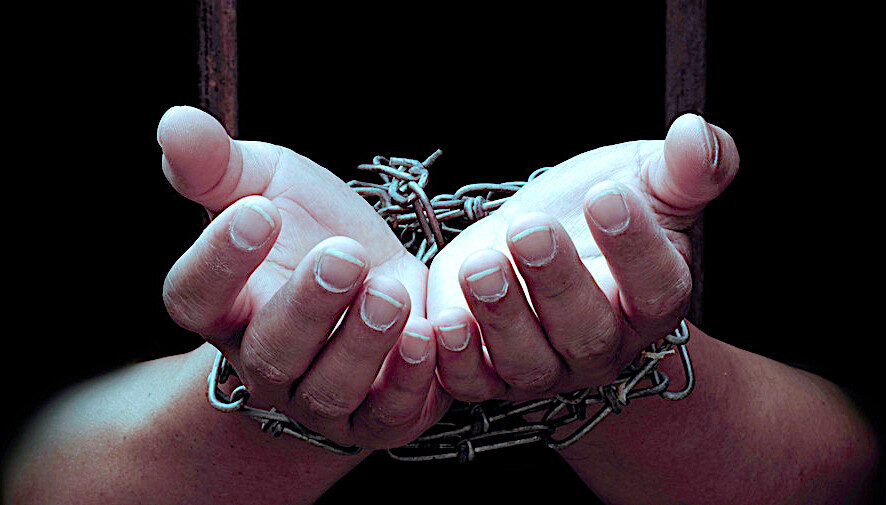

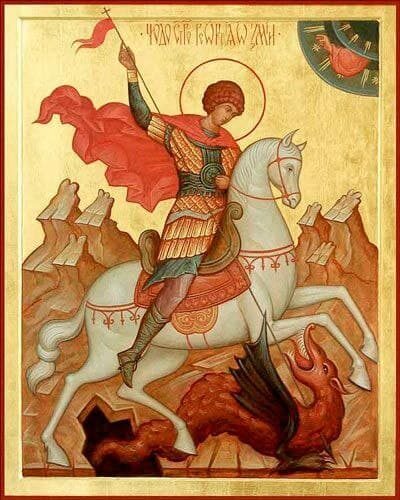
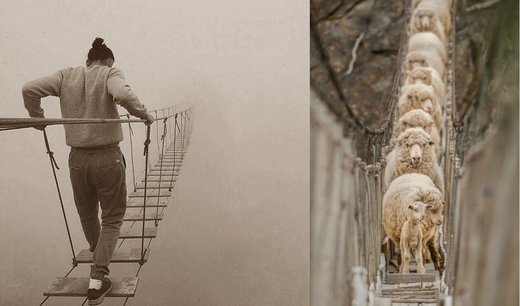
Kommentar: Ukraine has normalized undue cruelty and soulless brutality, the ideological and foundational byproducts of its orientation.